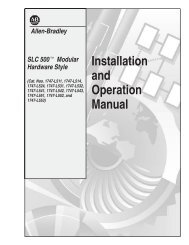1 Overview 2 Details of the Model Construction - Canada France ...
1 Overview 2 Details of the Model Construction - Canada France ...
1 Overview 2 Details of the Model Construction - Canada France ...
Create successful ePaper yourself
Turn your PDF publications into a flip-book with our unique Google optimized e-Paper software.
4. Windscreen position (3): Ei<strong>the</strong>r <strong>the</strong> windscreen was down, 50% raised or 100% raised.<br />
5. Vent plugs (3-4): The purpose <strong>of</strong> <strong>the</strong> vent plugs was to simulate throttling <strong>of</strong> <strong>the</strong> flow by<br />
completely closing some <strong>of</strong> <strong>the</strong> proposed dome vents. We investigated two configurations; one<br />
in which <strong>the</strong> upwind vents were closed and <strong>the</strong> slit was facing partially or completely upwind,<br />
with <strong>the</strong> windscreen at different positions, ano<strong>the</strong>r with similar dome orientations but with <strong>the</strong><br />
vents closed on <strong>the</strong> downwind side. For each configuration <strong>the</strong> maximum number <strong>of</strong> vent plugs<br />
were installed in <strong>the</strong> dome (up to 3 plugs) and a fixed set <strong>of</strong> experiments was run in each<br />
configuration, removing a single vent plug once a set <strong>of</strong> experiments was complete.<br />
At <strong>the</strong> time <strong>of</strong> <strong>the</strong> experiment, <strong>the</strong> configuration <strong>of</strong> vent plugs tested represented <strong>the</strong> most likely<br />
real-world operational configuration <strong>of</strong> <strong>the</strong> dome. Hypo<strong>the</strong>tically, with <strong>the</strong> upwind vents<br />
blocked, <strong>the</strong> effect <strong>of</strong> <strong>the</strong> wind on <strong>the</strong> telescope shake would be minimized. On <strong>the</strong> o<strong>the</strong>r hand,<br />
having <strong>the</strong> down-wind vents closed allowed us to investigate <strong>the</strong> potentially compromising<br />
effect on flushing time having <strong>the</strong>se vents closed. The reason we might want to have <strong>the</strong>se<br />
vents closed is that <strong>the</strong>re was an indication (prior to <strong>the</strong> tests, but later borne out by our<br />
experiments) that <strong>the</strong> downwind counter-flow might lead to entrainment <strong>of</strong> <strong>the</strong> warm air from<br />
<strong>the</strong> building exhaust into <strong>the</strong> dome.<br />
6. Dome position (4-13): The number <strong>of</strong> dome positions investigated for each dome configuration<br />
depended on <strong>the</strong> particular configuration with <strong>the</strong> vents and windscreen plugs installed. With<br />
<strong>the</strong> exception <strong>of</strong> <strong>the</strong> boundary layer investigation test, <strong>the</strong> dome positions explored were from<br />
90 o (dome slit facing east) through 180 o (dome facing south) to 270 o (dome slit facing west) in<br />
increments <strong>of</strong> 15 o . This was <strong>the</strong> case for each configuration in which <strong>the</strong> vent plugs were not<br />
installed. The north facing orientations were not explored due to <strong>the</strong> symmetry <strong>of</strong> <strong>the</strong> model<br />
and <strong>the</strong> lack <strong>of</strong> visibility into <strong>the</strong> dome with <strong>the</strong> slit facing north (due to <strong>the</strong> opaque dome<br />
shutter). Note however that <strong>the</strong> symmetry is not perfect due to <strong>the</strong> structures on <strong>the</strong> dome floor<br />
(e.g. <strong>the</strong> mezzanine on <strong>the</strong> south side <strong>of</strong> <strong>the</strong> dome floor). Note that in some configurations with<br />
<strong>the</strong> vent plugs installed, small angles to <strong>the</strong> ENE were explored.<br />
Typically, after 20 or more tests had been performed, <strong>the</strong> videos were downloaded to a laptop. This<br />
minimized <strong>the</strong> possibility <strong>of</strong> data loss as well as <strong>the</strong> loss <strong>of</strong> sequencing <strong>of</strong> <strong>the</strong> video files between <strong>the</strong><br />
two cameras. Care was taken to erase <strong>the</strong> camera memory after each download session so that file<br />
names on <strong>the</strong> side-view and bottom-view cameras would match. The laptop was backed up to an<br />
external disk every evening once testing for <strong>the</strong> day was complete.<br />
Most <strong>of</strong> <strong>the</strong> routine experiments involved first installing <strong>the</strong> maximum number <strong>of</strong> plugs (on a given<br />
upwind or downwind side) that would be used with a set dome (if applicable). The data taking would<br />
proceed by taking video at <strong>the</strong> defined set <strong>of</strong> angles for a given configuration (see next section for<br />
details), almost always in increments <strong>of</strong> 15 degrees. The probe configuration would <strong>the</strong>n be changed<br />
and a new sequence <strong>of</strong> video at <strong>the</strong> relevant angles would be taken. This provided <strong>the</strong> smoo<strong>the</strong>st data<br />
taking work flow. However, a few experiments did not fit this mold and <strong>the</strong>se are described below.<br />
8.2 Boundary layer investigation<br />
This was previously described in “Determination <strong>of</strong> <strong>the</strong> Operating Tunnel Flow Speed”.<br />
8.3 Flow Visualization Near <strong>the</strong> Heat Vent Locations<br />
The purpose <strong>of</strong> this experiment was to determine if <strong>the</strong> fluid in <strong>the</strong> vicinity <strong>of</strong> <strong>the</strong> heat vents to <strong>the</strong> NW<br />
and NE <strong>of</strong> <strong>the</strong> observatory could be drawn into <strong>the</strong> dome from certain orientations. The location <strong>of</strong> <strong>the</strong><br />
heat vents was visually estimated referring to <strong>the</strong> topographical map shown in Figure 14. A hand held



![Documentation [PDF] - Canada France Hawaii Telescope ...](https://img.yumpu.com/26965302/1/190x245/documentation-pdf-canada-france-hawaii-telescope-.jpg?quality=85)








